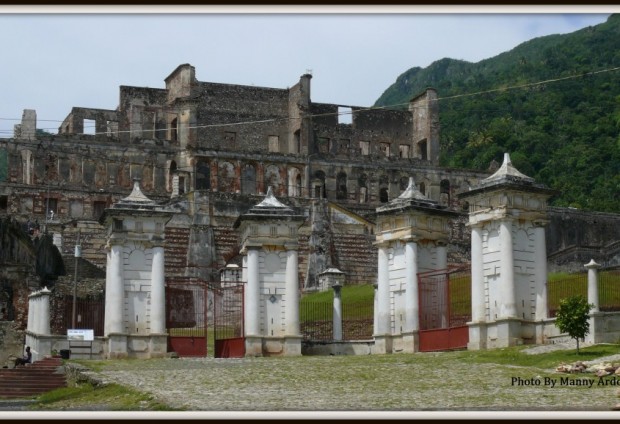Haiti’s Sans-Souci Palace : A journey to the past
By Bojan KvederMilot, Haiti

It is one of the most remarkable attractions in the Western Hemisphere, but the Palace of Sans-Souci in northern Haiti is seldom visited by foreigners.
Decades of political instability and lawlessness mean much of Haiti is avoided by tourists.
But the story of the sprawling palace complex, whose name means “Without Worry”, had fascinated me for more than 40 years.
It was the home of independent Haiti’s first monarch, Henri I, also known as Henri Christophe.
Continue reading the main story
Slave who crowned himself king

- 1767: Henri Christophe born, probably in Grenada. Taken to Saint Domingue as a slave
- 1791: Slave rebellion breaks out in Saint Domingue
- 1804: Haiti wins independence, abolishes slavery
- 1807 – Haiti divided in two; Henri Christophe leads northern Haiti, his rival Gen Alexandre Petion heads the southern Republic of Haiti
- 1810 – Henri Christophe starts building Sans-Souci Palace
- 1811 – Crowned King Henri I
- 1813 – Sans-Souci completed
- 1820 – Henri Christophe commits suicide
- 1842 – Earthquake damages Sans-Souci
- 1982 – Unesco designates Sans-Souci as World Heritage Site
Henri Christophe was one of the most prominent figures of the Haitian slave revolution of 1791-1804.
The end of French rule meant the colony of Saint Domingue, renamed Haiti after its original Taino Indian name, became the first black-led independent nation in the world.
But after independence Haiti split into two. Henri Christophe embarked on construction of his palace in 1810 and a year later declared himself king in northern Haiti. His sweetheart became Queen Marie-Louise.
Sans-Souci was completed in 1813, at the cost of hundreds, maybe even thousands of labourers’ lives.
A recent holiday in the neighbouring Dominican Republic, which shares the island of Hispaniola with Haiti, seemed too good an opportunity to miss to see the ruins.
I wondered if my 12-year-old daughter, Isabel, would share my fascination with this story.
I had first encountered it when I was roughly her age, enthralled by a play about King Henri I performed by a French modern theatre troupe.
As there are no organised tours to Haiti from the Dominican Republic, and very few taxi drivers willing to take the risk, finding a well-disposed man-with-a-van in Santo Domingo was like pulling teeth.
But eventually the man, Jose, materialised.
He turned up with a roomy, air-conditioned people carrier outside the Jaragua Hotel on Santo Domingo’s seaside drive.
“Yes, let’s go,” Jose said, adding: ”But remember, this is not a good time to visit there.”
“So when would be a good time?” I asked.
“Never, really,” he replied with a crooked smile.
Bitter memories
Like many of his countrymen, Jose takes a dim view of Haitians and their country, an attitude rooted in Haiti’s post-independence invasions of the Dominican Republic.
The sentiment is reciprocated by Haitians, who particularly resent a massacre of up to 30,000 Haitian migrant sugar-cane cutters by the regime of Rafael Trujillo in 1937.

We set out long before dawn, meandering through banana, coffee and tobacco plantations at the foothills of the Cordillera Central and arrived at the dusty border crossing of Dajabon, where many civilians carry guns and jumpy border police make life easier for you for a fistful of pesos.
Over the bridge on the Haitian side, the town of Ouanaminthe is a picture of chaos, misery and despair, with hundreds of Haitians trying to cross over into the Dominican Republic.
Heaps of rotting uncollected garbage are everywhere. Uruguayan and Chilean soldiers, part of the UN stabilisation force, try to maintain some kind of order.

We hired a Haitian man, Jouan, to show us the way to the palace, as it is not signposted in any meaningful way.
“This is a derelict non-country,” Jose the driver hissed under his breath. “I don’t trust anyone here. The Mickey Mouse banknotes they use don’t even have serial numbers!”
Jouan pulled out a grubby 50 gourde note and poked his finger into it time and again.
“Look, it has a serial number,” he said, adding proudly: “And it says senkantgoud – we’re the only country in the world to have Creole on our banknotes.”
“No you’re not,” I interceded sheepishly.
“Who else?” he asked, visibly crestfallen.
“Seychelles,” I replied, dampening his mood.
After passing through towns with colourful names such as Limonade and Carrefour La Mort on a highway built by the Dominican Republic after the 2010 earthquake, we finally made it to Milot.
Echoes of the past
Sans-Souci Palace rises majestically above the town like a broken crown.
The grand edifice is now a ruin, having been severely damaged by an earthquake in 1842.
At that time Haiti was reunited, Henri Christophe long gone, and no-one could be bothered to rebuild it.

Nevertheless, climbing its broad staircases, wandering through its spacious rooms and terraces, you can see why it is considered to be the Versailles of the Caribbean.
Some historians, however, believe it was modelled after Frederick the Great’s palace of the same name in Potsdam.
But Frederick’s palace symbolised the Enlightenment of the day, whereas its Haitian counterpart symbolised tyranny and megalomania.
Henri Christophe was a brutal kleptocrat, pretty much like most of Haiti’s rulers that came after him.
They say he blew his brains out with a silver bullet after suffering a stroke in 1820.
His widow, Queen Marie-Louise, emigrated to Europe and died in faraway Pisa in Italy, dreaming about the lavish balls on the terrace of her beloved Sans-Souci.
Source : http://www.bbc.co.uk/news/world-latin-america-17567230



No comments yet.